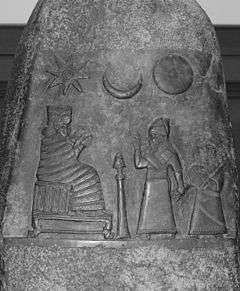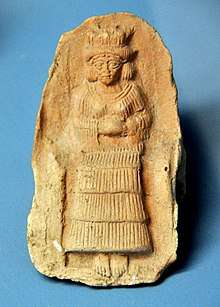Nanaya
Nanaya (Sumerian 𒀭𒈾𒈾𒀀, DNA.NA.A; also transcribed as "Nanâ", "Nanãy", "Nanaja", "Nanãja", or '"Nanãya"; in Greek: Ναναια or Νανα; Aramaic: ננױננאױ) is the canonical name for a goddess worshipped by the Sumerians and Akkadians, a deity who personified voluptuousness and sexuality,[1] and warfare.[2] Her cult was large and was spread as far as Egypt, Syria, and Iran. She later became syncretised as an aspect of Inanna.[3]

The Land grant to Ḫunnubat-Nanaya kudurru is a stele of King Meli-Shipak II (1186–1172 BCE). Nanaya, seated on a throne, is being presented the daughter of the king, Ḫunnubat-Nanaya. Kassite period limestone stele, Louvre.

Terracotta plaque of a seated goddess, Nanaya, from Girsu. Kassite period. Ancient Orient Museum, Istanbul
Notes
- Westenholz, 1997
- Livingstone, Alasdair. "A Hymn to Nanaya With A Blessing for Sargon II (1.141)".
- "A balbale to Inana as Nanaya (Inana H): translation". The Electronic Text Corpus of Sumerian Literature.
References
- Jordan, Michael (2005). Encyclopedia of Gods: Over 2,500 Deities of the World. Kyle Cathie. ISBN 978-1-85626-636-9.
- Drewnowska-Rymarz, Olga (2008). Mesopotamian Goddess Nanajā. Agade Publishing. ISBN 978-8387111410.
- Westenholz, Joan Goodnick (1997). "Nanaya: Lady of Mystery". In Finkel, Irving; Geller, Markham (eds.). Sumerian Gods and their Representations. Cuneiform Monographs. 7. Groningen: Styx Publications. pp. 57–84. ISBN 978-90-5693-005-9.CS1 maint: ref=harv (link)
External links
| Wikiquote has quotations related to: Nanaya |
- A tigi to Nanaya for Išbi-Erra (Išbi-Erra C), translation at The Electronic Text Corpus of Sumerian Literature
- Nanaja > Antiquity volumes edited by: Hubert Cancik and Helmuth Schneider. Brill Online, 2015, Brill Online Reference Works
This article is issued from Wikipedia. The text is licensed under Creative Commons - Attribution - Sharealike. Additional terms may apply for the media files.